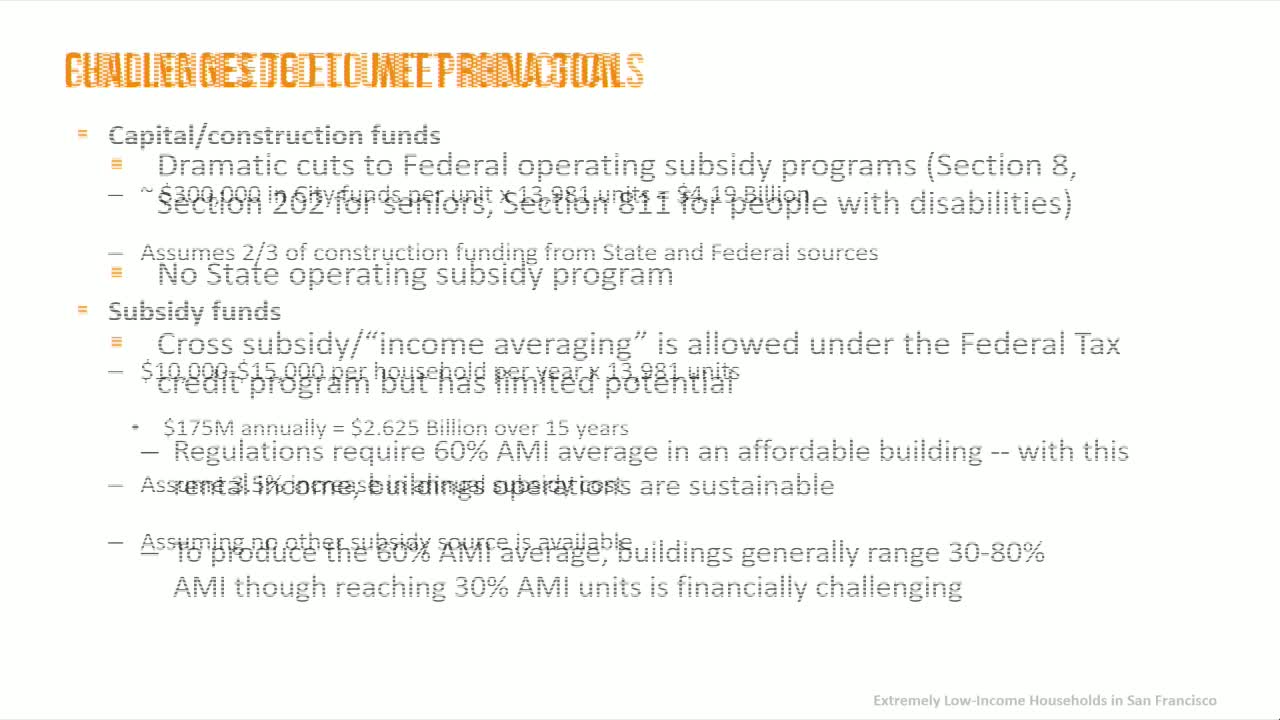San Francisco projects $4B needed to meet state housing goals over eight years
May 06, 2024 | San Francisco County, California

This article was created by AI summarizing key points discussed. AI makes mistakes, so for full details and context, please refer to the video of the full meeting. Please report any errors so we can fix them. Report an error »

In a recent San Francisco County government meeting, officials discussed the significant challenges facing the city in meeting state-mandated housing goals. The Regional Housing Needs Allocation (RHNA) requires San Francisco to build over 13,000 housing units in the next eight years, a target that many officials deem unrealistic given current financial constraints.
The discussion highlighted that the RHNA goals do not account for the realities of construction costs, interest rates, or funding availability. Estimates suggest that achieving these goals could require upwards of $4 billion in capital subsidies alone, with an additional $2.6 billion needed for operational costs over 15 years. This staggering financial requirement underscores the gap between state mandates and local capabilities.
Officials pointed out that while there are existing subsidies, such as those for senior housing, many projects remain stalled due to a lack of funding. The city has a pipeline of senior developments awaiting state allocations, but the necessary financial resources to move forward are still uncertain. The conversation also touched on the need for a comprehensive plan to address the housing crisis, particularly for extremely low-income (ELI) households, which have seen minimal new unit production in recent years.
The meeting also addressed the potential of the Faircloth to RAD program, which could provide long-term rental subsidies for low-income residents. However, the complexity of federal programs and the need for local budget authority to leverage these funds were acknowledged as barriers to implementation.
As the meeting concluded, officials emphasized the importance of collaboration among city departments to develop a clear roadmap for addressing the housing crisis. The urgency of the situation was palpable, with calls for a unified approach to secure the necessary funding and resources to meet the housing needs of all San Francisco residents. The next steps involve engaging stakeholders and formulating a detailed expenditure plan, with hopes of presenting a ratified plan by February 2025.
The discussion highlighted that the RHNA goals do not account for the realities of construction costs, interest rates, or funding availability. Estimates suggest that achieving these goals could require upwards of $4 billion in capital subsidies alone, with an additional $2.6 billion needed for operational costs over 15 years. This staggering financial requirement underscores the gap between state mandates and local capabilities.
Officials pointed out that while there are existing subsidies, such as those for senior housing, many projects remain stalled due to a lack of funding. The city has a pipeline of senior developments awaiting state allocations, but the necessary financial resources to move forward are still uncertain. The conversation also touched on the need for a comprehensive plan to address the housing crisis, particularly for extremely low-income (ELI) households, which have seen minimal new unit production in recent years.
The meeting also addressed the potential of the Faircloth to RAD program, which could provide long-term rental subsidies for low-income residents. However, the complexity of federal programs and the need for local budget authority to leverage these funds were acknowledged as barriers to implementation.
As the meeting concluded, officials emphasized the importance of collaboration among city departments to develop a clear roadmap for addressing the housing crisis. The urgency of the situation was palpable, with calls for a unified approach to secure the necessary funding and resources to meet the housing needs of all San Francisco residents. The next steps involve engaging stakeholders and formulating a detailed expenditure plan, with hopes of presenting a ratified plan by February 2025.
View full meeting
This article is based on a recent meeting—watch the full video and explore the complete transcript for deeper insights into the discussion.
View full meeting
